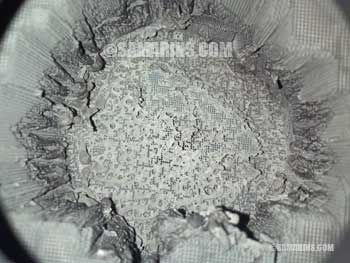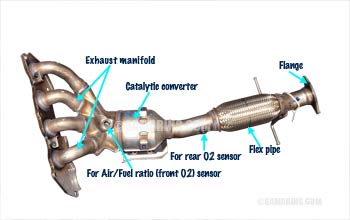Catalytic Converter: Problems, Symptoms, Testing, Replacement Options
October 09, 2022
The catalytic converter or "cat" is a key component of the vehicle emission control system. It reduces harmful exhaust emissions. 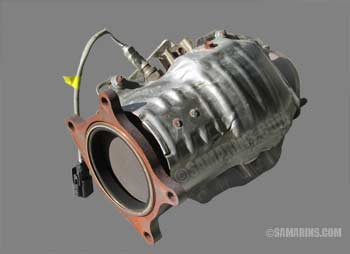 Catalytic converter. Larger image.
Catalytic converter. Larger image.Gasoline-powered cars have "Three-Way" Catalytic converters or TWC that reduce emissions of hydrocarbons (HC), carbon monoxide (CO), and nitrogen oxides (NOx).
Many modern cars and trucks have more than one catalytic converter, so if you have a problem with your catalytic converter, it's important to know which one.
The primary or front three-way catalytic converter is placed close to or within the exhaust manifold.
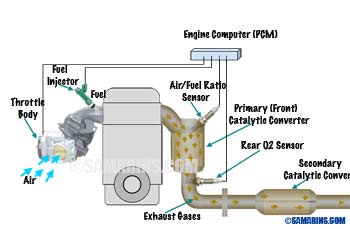 Catalytic converter exhaust emission control. Larger image.
Catalytic converter exhaust emission control. Larger image.The Air/Fuel ratio sensor (A/F sensor) is installed before the front catalytic converter and the rear oxygen sensor (Rear O2 or HO2S) is installed in the exhaust after the front catalytic converter. The job of the rear O2 sensor is to monitor the efficiency of the catalytic converter.
There may be another secondary or downstream catalytic converter (see the photo) placed further in the exhaust pipe. It could be called 'underbody catalyst'.
An engine with two cylinder banks (e.g., V6 or V8) has two front catalytic converters, both monitored by the A/F and Rear O2 sensors. Cylinder banks are designated Bank1 (the one that contains cylinder 1) and Bank2.
In some cars, the front catalytic converter is designated as a "warm-up" three-way catalytic converter, or WU-TWC, while the downstream converter is called TWC.
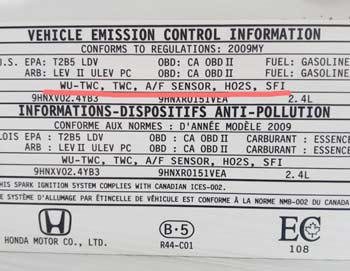 Vehicle emission control information sticker. Larger image.
Vehicle emission control information sticker. Larger image.For example, this sticker from the 2009 Honda Accord, located on the inside of the hood, says that it has WU-TWC and TWC catalytic converters as well as an air/fuel ratio or A/F sensor and a rear O2 sensor, or HO2S. SFI means sequential fuel injection.
The catalytic converter is covered by the 8-year 80,000-mile Emission Warranty.
In this article:
• Catalytic Converter Problems
• Symptoms of a Bad Catalytic Converter
• Catalytic Converter Testing
• Replacement Options
• How do Three-Way Catalytic Converters Work?
Catalytic Converter Problems
1. The Check Engine light stays on, with further diagnosis revealing trouble codes related to the catalytic converter: P0420, P0430 or P0421 and P0431. All these codes point to the efficiency of the catalytic converter falling below the threshold. We wrote a separate article that explains these codes and provides the information on testing: P0420 - Catalyst Efficiency Below Threshold.If your car has one of these codes, check with your dealer or do some research online for service bulletins or campaigns, as for some vehicles, there might be some extended warranty coverage available.
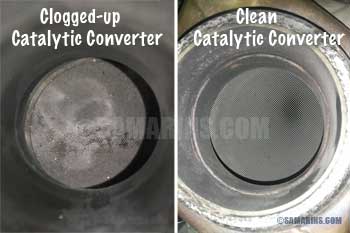 Clogged up versus clean catalytic converter. Larger image
Clogged up versus clean catalytic converter. Larger image3. Burned through, melted or disintegrated catalytic converter. As we were preparing materials for this article, we worked on a car with the catalytic converter code P0421. We cut the catalytic converter open to show you how it looks. As you can see, it's partially melted and disintegrated.
4. Physical damage. If the catalytic converter shows discoloration and other signs of overheating, it may have to be replaced. If there is physical damage such as cracks that cannot be repaired or if the catalytic converter is built into the exhaust manifold that has a broken runner, it will also have to be replaced.
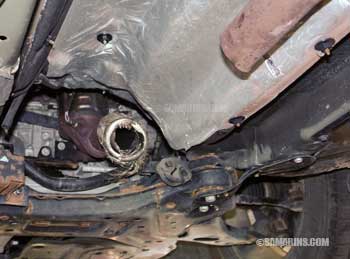 The catalytic converter has been stolen from this vehicle. Larger image
The catalytic converter has been stolen from this vehicle. Larger imageSymptoms of a Bad Catalytic Converter
- Check Engine light staying on with codes P0420, P0430 or P0421 and P0431. Often, there are no driveability issues with these codes.
- Smell or unburned fuel from the exhaust like from an old car from the 50s.
- If the inner ceramic monolith of the catalytic converter has broken apart, you may hear a rattling noise coming from the catalytic converter, like it has loose rocks inside.
- If the catalytic converter has burnt through, the exhaust may sound louder than usual.
- If something causes the catalytic converter to overheat, you may feel the excessive heat coming from the engine bay or the engine may produce clicking after it's shot down and parts are cooling down.
- Symptoms of a clogged-up catalytic converter include a lack of power on acceleration. The engine may run normally at idle, but bog down when revved. Often the engine runs hot if the exhaust is restricted. The EGR valve can also be burned through as a result of a clogged catalytic converter.
Catalytic Converter Testing
With a scan tool: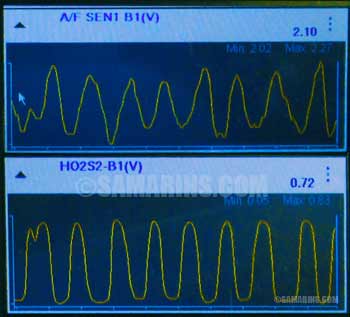 Bad catalytic converter. The rear O2 sensor signal (below) repeats the A/F ratio (front O2) signal (above). Larger image.
Bad catalytic converter. The rear O2 sensor signal (below) repeats the A/F ratio (front O2) signal (above). Larger image.Testing the catalytic converter for clogging up: Mechanics test the intake vacuum or measure the exhaust back pressure through the air/fuel ratio sensor opening to confirm a clogged-up catalytic converter.
If the intake vacuum drops when RPMs increase or if the back pressure measured at the air/fuel ratio sensor opening is more than 2.5 psi at 2,000 RPMs, the exhaust is restricted or the catalytic converter is plugged up. Many shops have borescope cameras that mechanics use to check for blockage visually.
Measuring the catalytic converter temperature with the infrared thermometer: A working catalytic converter burns off the unburned fuel and oil vapors coming out of the engine. For this reason, the exhaust pipe temperature right after the catalytic converter should be higher than the temperature of the upstream exhaust pipe before the catalytic converter. If the catalytic converter is empty or burned through, the pre-cat exhaust pipe will have higher temperature.
Read more in this article: Code P0420 Catalyst Efficiency Below Threshold (Bank 1).
Catalytic Converter Replacement Options
If the catalytic converter has failed, it's important to find out what caused the catalytic converter to fail. Is it because the engine consumes a lot of oil, or due to some other engine defect? The new catalytic converter will not last long if the root cause is not repaired.If the air/fuel ratio sensor or oxygen sensor in the old converter is seized and cannot be removed without damaging it, or if it has been stolen together with the cat, it will need to be replaced too.
Replacing a catalytic converter is not cheap, so consider all your options. Some states (e.g., California, New York, Maine, Colorado) have stricter standards and require replacement catalytic converters to be CARB-compliant (California Air Resource Board). Check your local laws first.
1. The first option is to visit the dealer and have them replace the catalytic converter with a new OEM part. This option is good if you want to use the original part and don't mind paying top dollars for it, or if your insurance covers it. Your dealer will not have the part in stock, but they should be able to get it for the next day or within a few days if the part is available. Of course, we did some research and found that for certain models that are common targets for catalytic converter theft, parts are not available or on back-order.
For an average car with a 4-cylinder engine, the catalytic converter replacement will cost 1.5-2.0 hours of labor plus the part and hardware plus the diagnostic charge, if it was needed. Some OEM catalytic converters are priced over $1,000. Some CARB-certified catalytic converters could cost twice as much.
2. The second option is to use a direct-fit aftermarket catalytic converter. Check Amazon or eBay indicating your car's year, make, and model or search Google for online prices. You can find a much cheaper aftermarket cat that fits your car. You can have it installed at any shop, but it's important to inquire about the warranty; we know cases when after installing the aftermarket catalytic converter the Check Engine light with the catalytic-related fault code came back. For example, some Chrysler vehicles are known to set the code when aftermarket catalytic converters or air/fuel ratio sensors are used. The labor charge will be the same, 1.5-2.0 hours for an average 4-cylinder car, but the part will be cheaper than the OEM.
3. The third option is a universal catalytic converter which is much cheaper, although it will not fit all cars. For example, it will not fit in cars that have the catalytic converter built inside the exhaust manifold as one unit. In some cars and trucks, however, a universal converter can be welded fairly easily in or even attached with clamps. Check with the local muffler shop as they may be able to fabricate the part on the spot using a universal converter. We recently got this option done at our local muffler shop for the Subaru Forester we had and it worked well.
4. The fourth option, is to buy a used part. This option is often considered if the catalytic converter is built inside the exhaust manifold. A used catalytic converter might be harder to find and the condition of a used part is questionable, but we have seen cases where a used part was the most affordable option and it worked. Your repair shop can check with local auto recycling facilities (wreckers) to source the part.
How do Three-Way Catalytic Converters Work?
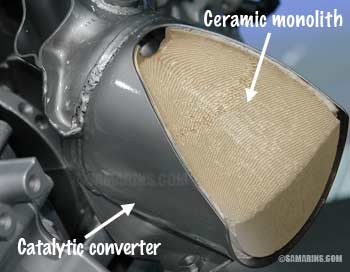 Catalytic converter inside. Ford display. Larger image.
Catalytic converter inside. Ford display. Larger image. The monolith is coated with catalyst elements, such as Platinum (Pt), Rhodium (Rh), Palladium (Pd) and Ruthenium (Ru). A catalyst is a substance that enables a chemical reaction but is not consumed in it. As exhaust gases pass through a sufficiently warmed-up catalytic converter, chemical reactions take place. The job of a three-way catalytic converter is:
1. Burn off unburned fuel and oil vapors (hydrocarbons or HC), converting them into carbon dioxide (CO2) and water (H2O). The simplified formula is:
a CxHy + b O2 → c CO2 + d H2O
2. Convert carbon monoxide (CO) to carbon dioxide: (CO2):
2 CO + O2 → 2 CO2
3. Reduce emissions of nitrogen oxides (NOx), converting them into nitrogen (N2) and oxygen or carbon dioxide, for example, one of the ways is:
2 NO + 2 CO → N2 + 2 CO2
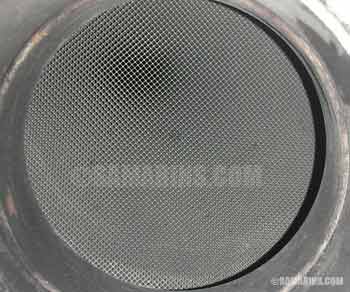 Catalytic converter honeycomb. Larger image.
Catalytic converter honeycomb. Larger image. The three-way catalytic converter is more effective when the engine is running at stoichiometric air-fuel ratio which is about 14.7:1 for gasoline engines. It means 14.7 parts of air to 1 part of gasoline fuel. To maintain the stoichiometric air-fuel ratio, the engine computer or PCM uses the signal from the air/fuel ratio sensor (front O2 sensor) that is installed before the primary catalytic converter. The rear O2 sensor monitors the efficiency of the catalytic converter. See how the sensor signals look in the scan tool in this article: Code P0420 Catalyst Efficiency Below Threshold (Bank 1).
